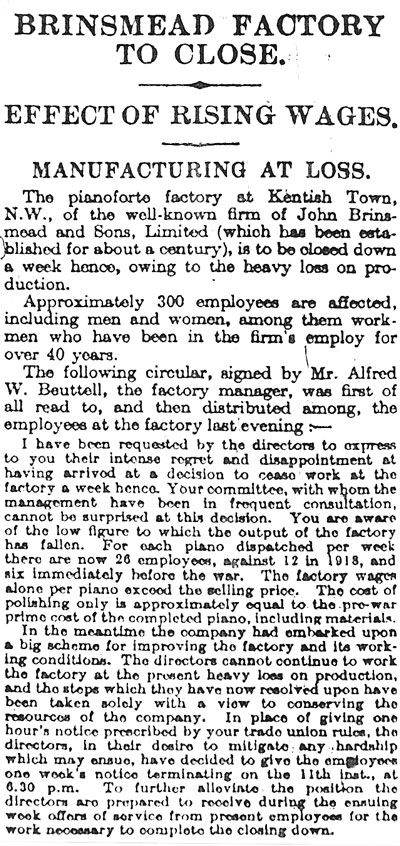The Factories
John Brinsmead began making pianos in the rabbit warren of similar establishments around Tottenham Court Road. There were many small time operations in the area. The first place of business was at 40 Windmill Street. This was also the family home for John, wife Susan, and first child John. The 1841 census shows others living there as well, so it must have been a fairly confined space. They remained there for about three years.
15 Charlotte Street
John Brinsmead bought a lease on a house close by to Windmill Street. The family moved in and he built some workshops in the back. It remained his residence for some time, even after the factory moved to Chenies Mews. One article accounts how the Charlotte Street factory burnt to the ground.
In 1850, when Mr. Brinsmead was working night and day in preparation for the Great Exhibition of the following year, and his Charlotte Street factory was crammed with valuable timber and partly-completed pianos, the entire establishment was burnt to the ground. The blow was a terrible one at the time, and nearly crippled him. His reputation stood high even then, however, and the rest of the trade rallied nobly round him in the hour of his misfortune, supplied him with timber and other necessaries, and helped him over the worst with such good result that when the Exhibition came, he was able to carry off the first award for his pianos.
1 Chenies Mews
The first factory of significant size was located at 1 Chenies Mews, just a few minutes walk from Charlotte Street and Windmill Street. The building was a three storey structure, 110 feet long by 30 feet wide, described as being parted off in several places as workshops for rough work, fine work, finishing, and polishing houses. The 1861 census tells us that John Brinsmead employed 35 men and 8 boys.
The Chenies Mews factory was located near the present Goodge Street Underground Station. It was between Tottenham Court Road and Gower Street and appropriately enough close to Torrington Place.
The Second Fire
In late May of 1861 a fire broke out at John Brinsmead's 1 Chenies Mews factory. The newspaper account tells us that "flames shot forth from every window and loophole in the building, making a frightful noise. A neighbouring piano maker, Messrs. Oeztman and Plumb, kept wood undergoing seasoning on their workshop roof, and the flames spread there and then to the roofs, skylights, and stables in Chenies Mews. The damage, which was insured, amounted to £10-12,000.
Moving to Kentish Town
The Kentish Town Factory on Grafton Street was built in stages. The original factory, built from plans drawn up by John Brinsmead himself, was built in about 1871. In 1881, it was expanded considerably. According to an article written about a month before the expanded factory opened, it was said that there were 300 employees, and 300-400 pianos in the process of manufacture at any given time. They were selling about 50 pianos a week and had a three month's backlog on orders. By 1886, the firm was said to have expanded to 400 workers producing 60 pianos each week.

Wartime Use
The war was a difficult time for the Brinsmead Piano factory. Many employees joined up; one hundred alone signed up for Lord Kitchener's Army in 1914 and by the end of the war a full 70% had gone to war. The firm, although not obliged to do so, continued to top-up the wages of those who served. The government considered the piano trade a non-essential luxury business and rationed the supply of wood and metal. The operations of several suppliers were converted to munitions. Half-finished pianos were simply stockpiled pending the end of the war. In 1917, the firm was being converted to take on munitions orders of its own and was believed to have been involved in the construction of aircraft.
An interesting initiative, carried out in anticipation of a need to recruit trained workers after the war, was to work with interned British prisoners of war in Switzerland training them for the trade.
 Newspaper account of the closure
Newspaper account of the closure
The Decision to close
On the evening of February 4th, 1920, the 300 employees of the factory were told the decision had been made to close down the factory one week later and stop the manufacture of pianos entirely.
There was much debate in the press about the causes of the firm's demise. One obvious cause was the loss of skilled workers due to the war. A high proportion of Brinsmead's workers had gone off to war and faired no better than the next man when it can to "going over the top". A second factor was the continuing restriction on the import of the necessary raw materials and there high price, even when available.
A third factor was the post-war introduction of the minimum wage to replace piece work, which had been the pre-war norm in the industry.
The workers complained that the cause was having to work with inferior wood, and the inexperience of management in the piano trade. Management pointed to the influence of trade unions, and to the prospect, once again, of creeping German competition, a theme the firm had pursued vigorously before and during the war.
Post-war Use
On March 16, 1921, the receiver for John Brinsmead and Sons Ltd. held an auction to sell off 100 pianos, at prices ranging from £62 to £144, slightly less than had been hoped for. Two months later the receiver obtained a Court Order to sell the freehold interest in the factories in Kentish Farm. The advertisement advised that "The freehold has a frontage on four street, and a site of 32,000 square feet. The floor space exceeds 61,000 square feet. The premises are properly equipped, and have electric lifts".
Despite the closing of the factory, the Brinsmead name still had value, and the trade name was taken over by other firms and continued in use until the 1950's. However, the pianos produced after 1920 were Brinsmead pianos in name only. In November, 1923, the Brinsmead piano selling business was moved from the Wigmore Street premises just down the street to 17 Cavendish Square, the former residence of Lord Bessborough.
We believe that at least one part of the factory was put to use as Dell's Toffee Factory. It was seriously damaged in the blitz by a torpedo bomb. In 1967, a new resident moved in. Delbanco Meyer & Company Ltd was formed in 1936 and became the largest bristle merchants in the world.
The Factory Today
In 2012, what remained of the Brinsmead Piano Factory in Kentish Town underwent a renaissance with its conversion to an upscale set of nine flats and a penthouse, all designed for young professionals, plus 9,300 square feet of office space. The development has a website with a description of the project and its features. The interior designer also has a page about the Brinsmead project.

